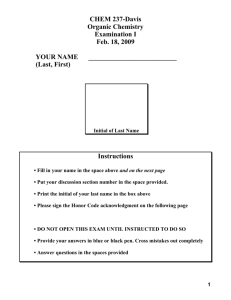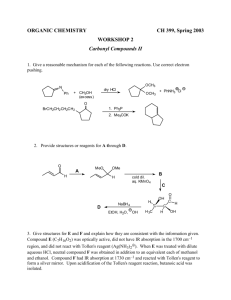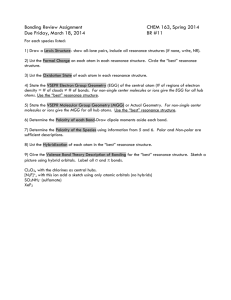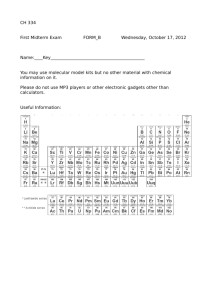Exam 1 KEY - Chemistry
advertisement
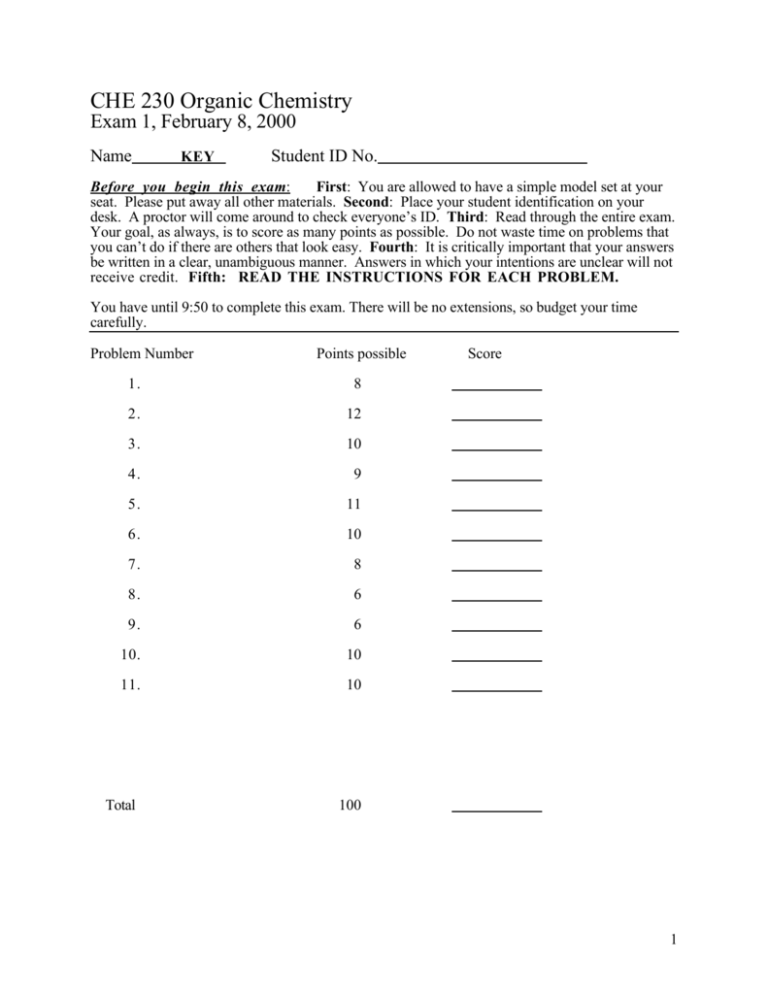
CHE 230 Organic Chemistry Exam 1, February 8, 2000 Name KEY Student ID No. Before you begin this exam: First: You are allowed to have a simple model set at your seat. Please put away all other materials. Second: Place your student identification on your desk. A proctor will come around to check everyone’s ID. Third: Read through the entire exam. Your goal, as always, is to score as many points as possible. Do not waste time on problems that you can’t do if there are others that look easy. Fourth: It is critically important that your answers be written in a clear, unambiguous manner. Answers in which your intentions are unclear will not receive credit. Fifth: READ THE INSTRUCTIONS FOR EACH PROBLEM. You have until 9:50 to complete this exam. There will be no extensions, so budget your time carefully. Problem Number Points possible 1. 8 2. 12 3. 10 4. 9 5. 11 6. 10 7. 8 8. 6 9. 6 10. 10 11. 10 Total Score 100 1 1. (8 points) Draw in the lone pairs of electrons (if any) on the compounds below. H 3C N O C H CH3 B H H CH3 P H 3C CH3 H H H H B N H H 2. (12 points) The structure of the antibiotics Amoxicillin and Zithromax are shown below. Identify the hybridization at the atoms indicated. This nitrogen atom is ___sp3_ hybridized This nitrogen atom is __sp2__ hybridized NH 2 H N O O S N CO2H This oxygen atom This carbon atom is __sp2__ hybridized is __sp2__ hybridized CH3 CH3 HO HO CH3 N CH3 HO N CH3 O HO CH3 H 3C O This carbon atom is __sp3___ hybridized CH3 O O CH3 H 3C O O CH3 OH H 3C This oxygen atom is ___sp3__ hybridized 2 3. (10 points) Draw 5 isomers of C6H10. Each of the structures you draw must have no formal charges and no unpaired electrons. Note: There are many acceptable isomers of C6H10 - if you draw more than 5 we will only grade the first 5. Here are some that are valid: 4. (9 points) Circle the most acidic compound of each pair below. a) O F O OH OH F b) OH OH c) OH OH NO2 NO2 3 5. a) (6 points) Provide a brief explanation for why phenol (pKa=10) is a million times more acidic than 2-pentanol (pKa=16). Do not exceed the space provided. OH OH pKa=10 pKa=16 The conjugate base of phenol (phenoxide ion) is stabilized by resonance. The conjugate base of 2-pentanol is not stabilized. b) (5 points) Which side of this equilibrium is favored? (Circle it) OH O O + 6. OH + (10 points) Draw the Lewis dot structure for each of the species below and determine the formal charge on the central atom. a) H H B H H H H B H H There is a formal -1 charge on B b) H H N H H H H N H H There is a formal +1 charge on N 4 7. (8 points) Draw 4 new resonance forms for the compound shown below. You are not being asked to show arrows in this problem, but be sure you keep track of all charges and bonds. OCH3 N O O Here are some to choose from: OCH3 N O OCH3 O N O OCH3 N O 8. O OCH3 O N O OCH3 O N O O OCH3 N O O (6 points) For each pair of structures, identify the relationship as the same compound, resonance forms of the same compound, skeletal isomers, or different (not resonance forms and not skeletal isomers). a) N H N H These are resonance forms b) These are the same compound 5 c) O O These are resonance forms 9. (6 points) In each compound, circle all atoms in any conjugated π-systems. If you believe that a particular compound does not have a conjugated π-system, write ‘not conjugated.’ a) H C H H C C H H C H C C C H H H H b) H N O C H N H H S C O O H (Biotin) 10. (10 points) In compounds like the enamine below, nitrogen adopts sp2 hybridization so that the lone pair can interact with the π-bond. Draw this compound (in 3-D to the best of your abilities) using ‘sticks’ (lines) for the σ-bonds and lobes for the p-orbitals on each atom. Sketch in the overlap of p-orbitals. (Please draw large enough to make your intent clear) H H C H C N H H 6 H C H C N H H H 7 11. (10 points total) You will see in future chapters that compounds like aniline are very susceptible to attack by electrophiles because the resulting cation (show in a), below) can be stabilized by the lone pair of electrons on nitrogen. (6 points) Show this resonance interaction by drawing the arrows that show the movement of electrons to form the most stable resonance form of the cation. Be sure that you correctly use the arrows for movement of electrons and for designating a new resonance form. a) H Br H Br H H N N Cation stabilized by lone pair on N You will also see that cations like the one shown below are not stabilized by the lone pair on nitrogen. (4 points) Provide a brief explanation for why the lone pair on nitrogen in b) is not able to stabilize the cation through resonance. A drawing may help you explain the phenomenon, but do not exceed the space provided. b) Br H H N Cation not stabilized by lone pair on N H H N Br H C C H The lone pair on N is in an sp2 hybrid orbital, and is perpendicular to the p orbitals that make up the π system. There is no overlap between the sp2 hybrid and the π system, so there is no way this pair of electrons can participate in resonance END OF EXAM 8




